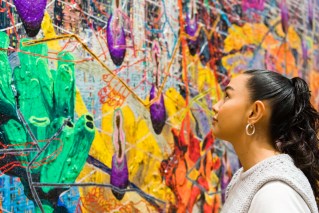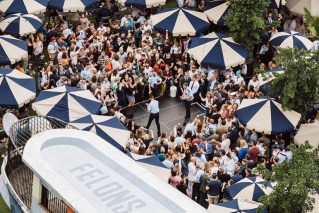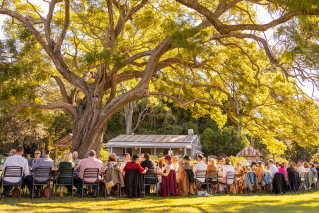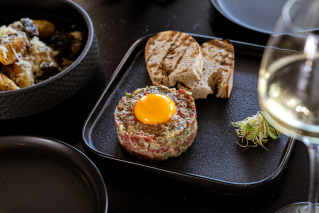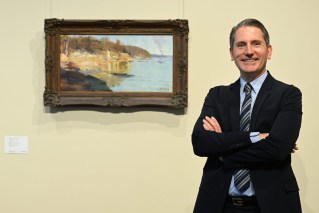Singing see-saws and randy robots: Wild and weird, but it’s all in the name of science
South Bank Parklands has been transformed into a swarm of interactive robots and singing semi-intelligent seesaws as feature interactive exhibits in the World Science Festival until April 2.
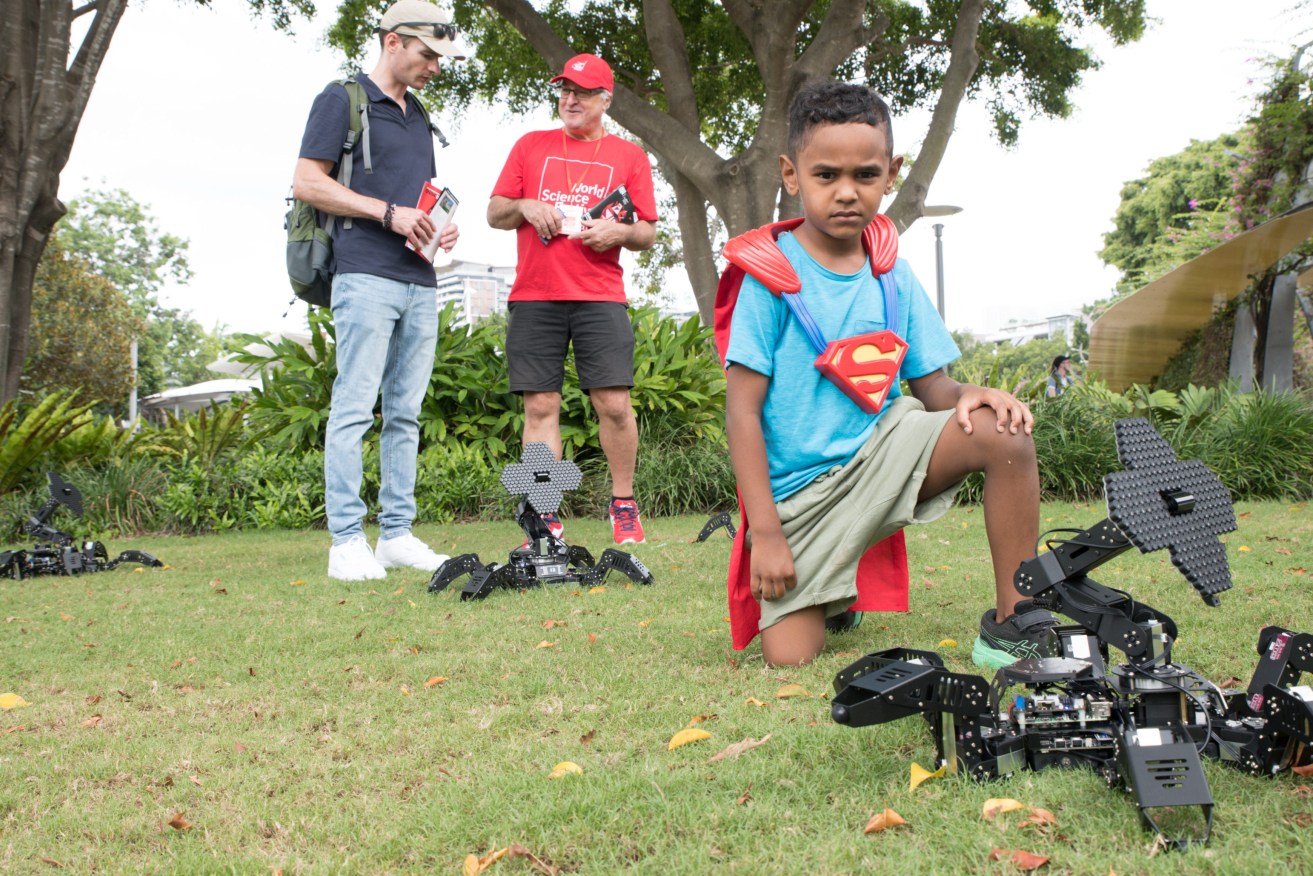
The World Science Festival has brought all manner of interactive bots to South Bank. (Image: supplied WSF)
Becoming emotionally intimate with a swarm of 15 robots is not something many of us have imagined, however that’s what’s happening at the South Bank Parklands Riverside Green for those brave enough to immerse themselves in the encounter.
It’s called Cybernetic Intimacy, and for co-creator Adam Donovan it’s all about creating a space where people can interact with semi-autonomous robots and learn how to communicate with them through the robots’ distinct body language and behaviours.
It’s part of the World Science Festival, which was founded in New York in 2008 by celebrated physicist and science author Professor Brian Greene and award-winning broadcast journalist Tracy Day.
Brisbane is the only other city in the world to host an international extension of the event, with an innovative program at the juncture of art and science that explores some of the biggest social, cultural and scientific questions facing Queenslanders today.
Being part of the festival is a homecoming for QCA graduate Donovan, who created Cybernetic Intimacy with his partner Katrin Hochschuh from their base in Germany as part of their long-running inventive partnership creating interactive philosophical playgrounds around the world.
Donovan said part of the joy of this the worldwide premiere of their latest artistic endeavour Cybernetic Intimacy – is watching how people interact with the robots they encounter up close.
“Typically, people aren’t very shy. These robots are a little bit maybe more spider-ish looking, a bit more creepy looking,” he said.
“And our experience so far is that – children in particular a little bit, oh gee, what’s that? It doesn’t take them long to do that. Their curiosity overcomes their hesitation – I’m not sure what this is – and they go and check it out.
“So this is something that we look in from psychology. I personally like to look at really old psychological research from say the 1940s, because these are a lot of interesting questions for me.
“There was one called An Experimental study on Apparent Behaviour, which was written by Fritz Heider and Marianne Simmel. What they showed in this study was that we are hardwired for compassion. So we inherently want to draw this conclusion of this apparent behaviour from things, from objects.
“And we use that as to create this effect of, a sense of co-habitation.”
While at the Little Stanley Green, a field of talking and singing seesaws questions the possibilities, hilarities, and potential failures of the interactions between humans, machines and artificial intelligence in Pivot.
Created by Madeleine Flynn and Tim Humphrey, Pivot comes alive by the way that people interact and respond to the semi-intelligent seesaws.
Flynn said what catches most people by surprise is how each seesaw listens and responds to its rider through speech, with each piece able to speak 20 different languages to create poetic narratives of our times that can be heard up to 20 metres away.
“It feels like sort of opening a door to see how audiences will respond, and it feels like there’s a whole set of things that are actually coming together that’s going to make it super interesting to see how audiences respond,” Flynn said.
“Because of the recent public discussions around Chat GPT and the implications around that. And then we are also putting that into public space with interaction with people. There’s a couple of interesting tensions that are coming together.”
That interaction between what initially seems like a benign piece of playground equipment and the people who approach creates fertile ground for realising the potential of robots and humans.
“So in a way, it’s like a big, beautiful, never ending writing exercise because everything that is being written, everything that the audience hears comes from this big library that we have written,” Flynn said.
“For us as artists, what we get to do that with audiences, we get to have experiments with audiences.
“Those agents or those characters have a point of view, and we can adapt that point of view. It’s interesting to see what happens what people’s responses are. So that will often give us new ways to add into the agents.
“For us, it’s like big playground of investigation, possibility. It’s been a place where we could try different things. And because it’s the form of a seesaw it’s inherently got a physical fun thing in lots of ways the seesaw has been risk assessed out of playgrounds.
“They’re public conversations too and that’s a nice thing about them sort of being witnessed and shared also. It’s ridiculous. It’s pretty funny.
“The bigger questions for us around these things, around what is happening for us as cultures and how we manifest those things publicly. How we might be afraid of something or how we might connect with something.”
Humphrey gets great joy from watching the Pivot seesaws – or agents as they call them – interacting with different audiences around the world.
“I think it’s important that what Pivot represents is somehow a joyous unreliability, because they rely on scraping through bulk loads of formal information, incorrect information, a whole lot of stuff that you can’t trust anything that it says, and you can definitely not trust any advice that Pivot would give you,” Humphrey said.
“The Pivot bot, we like to call it that. It does take quite a localised viewpoint in terms of how the people where it is at any particular time might respond to things.
“The fact that it belongs in the family of chatbots, but it’s not entirely comfortable in there. And it has quite a few reservations. It’s a little bit – you’d have to say – unstable. It has a few things that you might not expect that it might say. It’s a loose cannon. It’s a loose seesaw.”
Part of the joy of the World Science Festival giving a focus to such creative scientific projects, is that all of the exhibits effectively interact together to explore this rich intersection of art and science, which Donovan said enables new concepts to emerge.
“It is about creating these beautiful moments of space and time and sound, but also ask the question how we use technology, and for example, where AI is going, are we asking the right questions?,” he said.
“I design all the electronics, so I’m the hardware guy. I’m working a lot with circuit design and finding out what I can use sensor wise that might help the audience interact with the work or how they communicate to each other.
“We had thought of it as having a sound element as well. This (Cybernetic Intimacy) uses a parametric acoustic array – using ultrasound to create a virtual membrane of air that becomes the loud speaker itself.
“Say you’re standing in the middle of 15 robots, you’ll be able to point them at your head and there’ll be some psycho-acoustic effects, effects that your head will make, just sounds in itself. So yeah, it’s lots of fun.
“I think it’s really interesting to think about how we communicate with other seeming living things and non-living things.”
Donovan said its wonderful to be able to return to Brisbane and creatively raise questions about how we can best work with AI, describing Cybernetic Intimacy as “a psychological experiment in interspecies communication” where both have to learn aspects of a new language.
“I hope we come back home more actually. Brisbane has a great robotics department at QUT, and I mean, we almost, we were going to apply for a funded PhD programme there, but then Corona hit,” he said.
“I want this bright, shiny future where wonders can happen because of technology but it might not go that way.
“The psychological, the development of artificial intelligence where we, are we teaching it empathy, is it driving the markets in which it’s driven and why it’s being used?”

